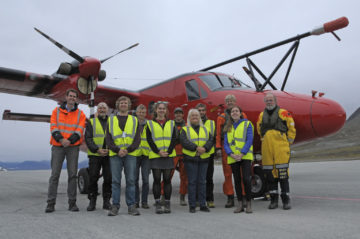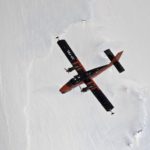Arctic Summer-time Cyclones
Arctic Summer-time Cyclones: Dynamics and Sea-ice Interaction
- Start date
- 1 November, 2020
- End date
- 30 November, 2024
The Arctic Summer-time Cyclone Project is a joint project of scientists from the University of Reading, University of East Anglia and the British Antarctic Survey with expertise in atmospheric dynamics, polar meteorology, sea ice dynamics, boundary layer turbulence and aircraft measurement science.
The overarching goal of the Arctic Summer-time Cyclones project is to determine the role of sea-ice surface properties in Arctic cyclone dynamics and to characterize the interaction of Arctic cyclones with the summer-time Arctic environment. The project focus on two important aspects of the Arctic environment where Arctic cyclones are hypothesized to be central: in their transport of sea ice during Very Rapid Ice Loss Events (VRILEs) and on the atmospheric temperature gradients (baroclinicity) around the Arctic ice margins, influencing subsequent weather systems and forecasts of Arctic climate from weeks out to a season ahead.
The overarching observational goal is to measure turbulent fluxes, radiation, surface topography, temperature and albedo, as well as cloud and aerosol properties within developing Arctic summer-time cyclones. The project uses campaign observations, a suite of operational forecasts provided by project partners, sensitivity experiments using the Met Office Unified Model and sea-ice modelling to meet the following project objectives:
1 To make observations characterizing low-level Arctic cyclone structure, development and interaction with Arctic baroclinicity and moisture gradients;
2 To measure surface layer turbulent fluxes over sea ice, the marginal ice zone and the open ocean during Arctic summer, particularly within Arctic cyclones;
3 To characterize the sea-ice surface (e.g., ice fractional coverage, albedo, roughness and topography) with simultaneous remote sensing measurements from the aircraft;
4 To identify sectors within Arctic cyclones where operational ensemble forecasts from different centres disagree, and momentum fluxes deviate from site-based observations;
5 To determine the dynamical mechanisms responsible for Arctic cyclone development using observations, from the tropopause to the surface;
6 To evaluate the importance of surface fluxes over sea-ice to the evolution of Arctic cyclones;
7 To identify the role of Arctic cyclones in sea-ice transport during VRILEs, and the competing mechanisms that can result in the loss of sea-ice volume in these events;
8 To quantify the interactions between Arctic cyclones and the strength of the Arctic Frontal Zone in the summer climate, and influence of surface fluxes on these interactions.
The project brings together expertise in observations, modelling and theoretical approaches to surface exchange, cyclone dynamics and sea-ice physics. We use novel theoretically-based approaches to interrogate forecast models as they run and determine the mechanisms through which the surface properties alter cyclone growth. A major legacy of the project will be the unique observations that will enable much needed evaluation and development of environmental forecast models for decades to come.
Russ Ladkin, BAS engineer

picture by D. Beeden
John Methven, PI (lead proposal), University of Reading Professor of Atmospheric Dynamics, Department of Meteorology
Ian Renfrew, PI, University of East Anglia Professor of Meteorology, School of Environmental Sciences
Andrew Elvidge, University of East Anglia Research Scientist, School of Environmental Sciences
Suzanne Gray, University of Reading Professor of Meteorology, Department of Meteorology
Daniel Feltham, University of Reading Professor, Centre for Polar Observations and Modelling
Ben Harvey, University of Reading Research Scientist, National Centre for Atmospheric Science
Oscar Martínez-Alvarado, University of Reading Research Scientist, National Centre for Atmospheric Science
Daniela Flocco, University of Reading Research Scientist, Centre for Polar Observation and Modelling
Ambrogio Volonté, University of Reading Research Scientist, Department of Meteorology
Hannah Croad, University of Reading PhD Student, Department of Meteorology

